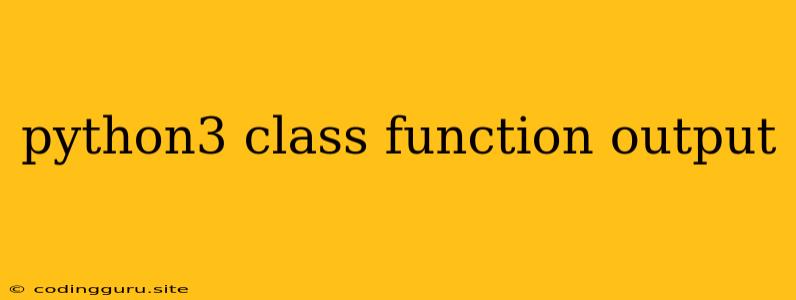Understanding Classes and Functions in Python 3
Python 3 is a powerful programming language known for its readability and versatility. One of the key features of Python is its support for object-oriented programming, which involves the use of classes and functions. Understanding how these elements work together is crucial for building robust and well-organized programs.
What are Classes?
Classes are blueprints for creating objects. They act as templates that define the attributes (data) and methods (functions) that an object of that class will have. Think of it like a cookie cutter - you can use the same cutter to create multiple identical cookies. In Python, a class is defined using the class keyword, followed by the class name and a colon:
class Dog:
pass
This code defines a class named Dog. The pass keyword indicates that the class is empty for now.
What are Functions?
Functions are blocks of reusable code that perform specific tasks. They help to break down complex programs into smaller, more manageable parts. A function is defined using the def keyword, followed by the function name, parentheses, and a colon:
def bark():
print("Woof!")
This code defines a function named bark which simply prints the word "Woof!".
Combining Classes and Functions: Methods
The real power of object-oriented programming comes from combining classes and functions to create methods. A method is a function that is associated with a specific class. It operates on the data (attributes) of objects created from that class. To define a method within a class, you simply write a function definition inside the class definition:
class Dog:
def bark(self):
print("Woof!")
Here, bark is a method of the Dog class. Notice the self parameter in the method definition. self is a reference to the object itself, allowing the method to access and manipulate the object's attributes.
Outputting from Functions and Methods
To output information from functions and methods, you can use the print function or return values.
Using print:
class Dog:
def bark(self):
print("Woof!")
my_dog = Dog()
my_dog.bark() # This will output "Woof!"
Returning a Value:
class Dog:
def bark(self):
return "Woof!"
my_dog = Dog()
bark_sound = my_dog.bark()
print(bark_sound) # This will also output "Woof!"
Both methods achieve the same result: printing "Woof!" to the console.
Example: A Simple Dog Class
Let's create a slightly more complex Dog class to demonstrate how classes, functions, and methods work together:
class Dog:
def __init__(self, name, breed):
self.name = name
self.breed = breed
def bark(self):
return "Woof!"
def introduce(self):
print(f"My name is {self.name} and I'm a {self.breed}.")
my_dog = Dog("Buddy", "Golden Retriever")
print(my_dog.bark()) # Output: "Woof!"
my_dog.introduce() # Output: "My name is Buddy and I'm a Golden Retriever."
In this example:
- The
__init__method is a special method called the constructor. It is automatically called when you create a new instance (object) of the class. - The
barkmethod simply returns the string "Woof!". - The
introducemethod prints a sentence introducing the dog's name and breed.
Tips for Working with Python Classes and Functions
- Name your classes and functions descriptively. This makes your code easier to read and understand.
- Keep functions short and focused. Ideally, a function should perform a single, well-defined task.
- Use docstrings to document your functions and methods. This will make your code more understandable for yourself and others.
- Consider using object-oriented programming principles like encapsulation, inheritance, and polymorphism. These concepts can help you design well-structured and maintainable code.
Conclusion
Classes and functions are fundamental building blocks of Python code. They allow you to create modular and reusable components that can be combined to build complex applications. By understanding the principles of object-oriented programming, you can write Python code that is clean, efficient, and easy to maintain.
